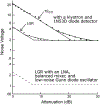Dispersion EPR: Considerations for Low-Frequency Experiments
- PMID: 35464635
- PMCID: PMC9030583
- DOI: 10.1007/s00723-021-01352-z
Dispersion EPR: Considerations for Low-Frequency Experiments
Abstract
The hypothesis is made that the dispersion electron paramagnetic resonance (EPR) spectrum can yield a higher signal-to-noise ratio than the absorption spectrum in diagnostic examinations if phase noise in the bridge is under control. The rationale for this hypothesis is based on the observation that the dispersion spectrum becomes more intense than the absorption spectrum at high incident powers. The rationale is dependent on optimization of high microwave efficiency (Λ; mT/W1/2) and low quality factor (Q-value) resonators as well as the use of microwave sources with reduced phase noise. Microwave frequencies from 1.2 to 94 GHz are considered. Although the dispersion display appears to be observable with an adequate signal-to-noise ratio for most EPR research initiatives, a weakness of microwave bridges for studies at high incident microwave power was identified. Spurious leakage of incident microwave power through the circulator, thereby bypassing the probe leading to the resonator, can result in a decreased signal-to-noise ratio in both absorption and dispersion because of phase noise. For dispersion EPR with low Q-value sample resonators, this leakage is the primary contributor to phase noise at the receiver. In this work, we focus on the design of microwave reflection bridges and discuss possible methods to ameliorate this source of noise.
Conflict of interest statement
Conflicts of interest/Competing interests (include appropriate disclosures) The authors declare that they have no competing interests.
Figures



References
Grants and funding
LinkOut - more resources
Full Text Sources
